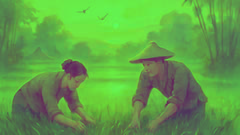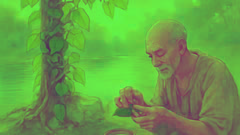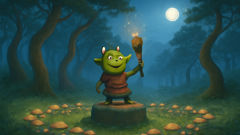Introduction
In the emerald heart of ancient Vietnam, where rivers coiled like dragons through jade fields and bamboo villages nestled under the patient watch of distant mountains, there once grew a story so cherished it became the lifeblood of tradition. The air shimmered with the perfume of frangipani and the gentle chorus of cicadas, and every path was lined with areca palms and the curling tendrils of the betel vine. Here, in a world defined by kinship, ritual, and the deep resonance of familial love, an old tale emerged to explain the birth of a custom and the origin of three sacred things: the areca nut, the betel leaf, and the limestone that binds them. In every Vietnamese wedding, in every village gathering where elders share laughter and secrets over the vivid red chew of betel quid, this story is quietly remembered—a story of two brothers, closer than the roots of ancient trees, and a woman whose heart beat between them. Their fates, shaped by the tides of love, jealousy, loyalty, and sorrow, would echo in the shape of the landscape itself. This is not just a legend for the old or the young, but a living thread in the fabric of Vietnamese culture, whispered with every offering of betel and areca, and retold wherever hearts seek meaning in devotion and loss. Journey now to the mist-wrapped dawn of Vietnam’s past, where every leaf and stone has its own voice, and discover the truth behind the betel quid—a story of family, heartbreak, and the eternal search for belonging.
Brothers Bound by Blood and Spirit
Long before the emperors built their citadels, before the rivers became highways for merchant boats, there lived in a humble thatched house two brothers whose lives were as entwined as the roots of the banyan. Their father, a respected scholar and healer, had named the elder Tan and the younger Lang. From childhood, Tan and Lang were inseparable—one never saw a single shadow on the village path, but two, moving together like the graceful wings of a heron in flight. When Tan laughed, Lang’s eyes shone. When Lang wept, Tan’s heart grew heavy. Their bond was forged not just by blood but by the silent language of shared dreams and unspoken promises.

In those days, the world moved at the rhythm of the seasons. The boys helped their father in the rice fields, their laughter rising above the green sea of stalks. At dusk, they would return home with bundles of wild herbs and stories caught from passing wind. Their mother had passed when Lang was still a baby, so Tan—though only two years older—became both brother and gentle guardian. Villagers would often pause at their gate, watching the two boys, marveling at their unity and kindness. It seemed to many that their happiness was untouched by sorrow, a rare blessing in a land sometimes shadowed by war and hunger.
But as seasons turned and the boys grew into young men, their father fell ill. His hair whitened like mountain mist, and his voice grew soft as falling rain. One evening, with Tan and Lang at his side, he pressed their hands together and spoke his final wish: “Never let the world come between you. Cherish each other, for brotherhood is stronger than fate.”
The old man’s passing left a hollow in their home, but his words remained, binding Tan and Lang as tightly as ever. Their life together was quiet but content, their days measured in hard work and evenings by the oil lamp’s gentle glow. The brothers’ love became legend—people said that if you saw Tan, Lang would soon appear, and that together they brought harmony to every task.
It was not long before the need for change entered their lives. Tan, as the elder, was urged by relatives and neighbors to take a wife and secure the family’s future. Reluctant at first, fearing the balance might shift, Tan eventually agreed, believing that a gentle woman could only add to their happiness. He soon married Lieu, the daughter of a nearby scholar—her beauty as quiet as moonlight on water, her voice as soft as silk, her heart generous and true.
Lieu entered their home not as a stranger but as a soothing presence. She tended to Tan’s needs, honored Lang as a younger brother, and carried out her duties with grace. The household thrived under her care. For a time, joy seemed endless—meals shared in laughter, the garden blossoming under three gentle hands, and every sunset painted with the easy peace of belonging. But in the delicate balance of affection, the seeds of change were quietly sown.
A Rift Wrought by Love and Fate
As time passed in their small, harmonious home, Lieu’s presence—meant to strengthen the brothers’ unity—began to shift the balance in ways none had foreseen. At first, the change was almost invisible: a slight lingering of Lieu’s gaze on Tan as she poured tea, a shared smile between husband and wife during the evening meal, a gentle touch on Tan’s sleeve as she passed by. Lang noticed these things and felt a subtle ache, one that grew deeper as the days unfurled. He did not begrudge them their happiness, but where he had once found himself at the center of Tan’s world, now he often saw only his brother’s back, turned towards Lieu.

Lang tried to adjust, helping more in the fields, rising before dawn to chop wood, seeking out moments with Tan when Lieu was busy. Yet, every attempt seemed to widen the gulf between them. Lieu, noticing his growing silence, tried to reach out to him with kindness—inviting him to help in the kitchen, preparing his favorite dishes, asking after his dreams. But Lang’s heart was restless. He felt himself a stranger in his own home, uncertain where he belonged. The warmth that once encircled the three of them seemed to fade, replaced by a silent tension neither Tan nor Lieu could mend.
One evening, after a rainstorm had rinsed the world clean and the air was thick with the scent of wet earth, Lang came upon Tan and Lieu laughing together beneath the eaves. Their intimacy was simple and innocent—nothing more than two people sharing joy. Yet, for Lang, it marked the moment he understood: he had become a guest in his brother’s heart, no longer the companion of his soul. The realization stung more than any loss he’d known.
Unable to bear the weight of longing and displacement, Lang slipped away before dawn the next day. He left no word, only a prayer whispered over the sleeping forms of Tan and Lieu. His footsteps carried him through dew-soaked meadows and silent forests, each step taking him further from the only family he’d ever known. As the sun rose higher, his sorrow grew heavier. Exhausted and broken-hearted, he reached a riverbank shaded by a tall areca palm. There, overwhelmed by grief, Lang knelt and wept. His tears fell into the rich earth, mingling with the roots of the tree. In that moment of sorrow, the world shifted: Lang’s form slowly faded, merging with the roots and trunk. He became the areca tree itself—tall, slender, unwavering—a silent witness to his own heartbreak.
Back at home, Tan and Lieu awoke to Lang’s absence. At first, they believed he had gone to the market or wandered to the fields. But as the sun arched across the sky and dusk deepened into night, worry grew into dread. Tan searched every path they’d walked together, calling his brother’s name until his voice grew hoarse. Lieu, her heart heavy with guilt and fear, prepared food that went untouched. Days passed in mounting desperation. Finally, Tan followed Lang’s favorite trail through the forests, his hope fading with every empty clearing.
When Tan found the areca tree by the riverbank, something in his heart recognized it instantly. He threw himself at the trunk, arms encircling its slender form as if to embrace his brother one last time. Overcome by grief, Tan’s tears mingled with the earth at the foot of the tree. As the sky darkened and stars blinked to life, Tan’s sorrow transformed him as well—his body turning to cold, white stone. He became a limestone rock, steadfast and unyielding, nestled against the base of the areca tree: a silent companion for eternity.
Lieu, left behind and wracked by guilt for the division her love had wrought, wandered in search of her lost husband and brother-in-law. She traced their steps through fields and forests, asking every bird and brook for news of them. At last, guided by a dream, she found the riverbank where the areca tree stood tall and the limestone rock rested at its roots. Understanding the truth—her love had cost her both men—Lieu collapsed in tears at their side. The earth opened gently to her sorrow, and her form dissolved into a green vine that wound itself around the areca trunk and limestone stone. She became the betel vine: ever-reaching, ever-clinging to both tree and rock, binding them in an embrace beyond death.
The Gift of Betel Quid: Tradition Born from Tragedy
The years rolled on, seasons spinning past the lonely riverbank where tree, stone, and vine clung to one another in silent witness. Their forms changed little as the world shifted: monsoons swept through, birds built nests in the palm’s feathery crown, and villagers sometimes passed nearby, noting the uncanny sight of an areca tree entwined with a vibrant green vine, rooted beside an oddly shaped limestone boulder. No one knew their story at first. But one day, an old woodcutter came upon the trio and felt moved by the unusual tableau. He sensed sorrow in the gentle rustle of leaves and a promise in the stone’s patient presence. He gathered a few betel leaves, plucked an areca nut, and chipped off a sliver of the limestone rock, guided by an urge he could not explain.

Back in his village, the woodcutter crushed the limestone and wrapped a slice of areca nut in a fresh betel leaf, just as his hands had done instinctively by the river. He placed the bundle between his teeth and bit down. A warming fire blossomed in his chest, tingling in his veins and sending a flush to his cheeks. When he spat, his saliva was bright red—an omen of vitality and warmth. Soon, others in the village tried this curious mixture. They found it brought clarity, ease of speech, and a strange sense of camaraderie.
Word spread quickly. Elders adopted the practice for their meetings; lovers exchanged betel quid as tokens of affection. It became a ritual at weddings: to offer betel quid was to declare pure intention and binding love, echoing the story of Tan, Lang, and Lieu. The custom flourished, weaving itself into the heart of Vietnamese culture—each quid a silent prayer for fidelity, unity, and remembrance.
Yet even as the ritual grew in popularity, the true story behind the sacred trio was passed on in whispers, sung as lullabies to children or told by firesides during festival nights. The legend became a lesson: that love is both powerful and perilous; that loyalty may demand sacrifice; that sorrow can be transformed into something beautiful and enduring. In every village and city, from delta to highland, the entwined fate of two brothers and a devoted wife lived on—rooted not just in folklore, but in every offering of betel and areca at life’s most important moments.
Today, betel quid remains a vibrant tradition at weddings, ancestor offerings, and village gatherings. It is a symbol of welcome and connection—a living link to a tale as old as Vietnam’s hills. And whenever someone reaches for betel and areca, they are, knowingly or not, honoring a story of devotion, loss, and the endless yearning for reunion.
Conclusion
In the tale of the betel and areca nut, Vietnam’s landscape is etched with the memories of three souls—two brothers whose love defied even death, and a woman whose sorrow became an eternal embrace. Their story is more than myth; it is a living bond between past and present, echoed in each betel quid offered at weddings or laid before an ancestor’s altar. Through heartbreak and hope, unity and sacrifice, Tan, Lang, and Lieu remind us that love can outlast separation, transforming grief into ritual and memory into celebration. Even now, every areca tree reaching skyward, every curling betel vine, and every limestone pebble underfoot holds a fragment of their devotion—proof that the most lasting traditions are born from the deepest human longing for connection and belonging.













